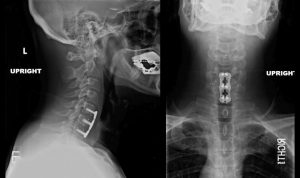Anterior Cervical Discectomy Surgery with Fusion
For Neck & Arm Pain Relief Caused By Cervical And Neck Fusion
The vertebral bodies in the neck are separated by discs. When disc material herniates, it can press on either the spinal cord or the nerves traveling to the arms. The patient may experience pain traveling down the arm in the distribution of the compressed nerve, or the patient may experience weakening or partial paralysis in the arms and legs below the level of the spinal cord compression by the disc.
An operation can be performed to go through the front of the neck, remove the disc, replace the interspace with a graft to fuse the adjacent vertebral bodies and place a small metal plate into the front of the vertebral bodies to secure them properly in place.

An anterior cervical discectomy with fusion and plating may be performed to help with arm pain and neck pain. It may also be performed to prevent worsening of paralysis in cases of spinal cord compression.
Before the operation begins, the anesthesiologist will put the patient to sleep. Then the front of the neck is prepared for surgery.
On either the right or left side of the neck, the neurosurgeon will make an incision and approach the front of the spine. After confirming the appropriate level, the neurosurgeon will remove the disc, bone spurs and ligament and prepare the endplates of the vertebral body to accept a graft and promote a fusion from one vertebral body to the next. The neurosurgeon will then place a small metal plate across the interspace to ensure stability until the bone has had a chance to fuse.
Before closing the incision, positioning of the instrumentation is checked with the intraoperative x-ray. The incision is closed with sutures and the skin is closed with glue.
Patients are typically discharged home the day after surgery. They should keep the wound dry and clean until given clearance by the neurosurgeon to get it wet.
Risks of the surgery are quite low. Potential risk includes bleeding, infection, injury to nerves in the neck, trouble with speech and swallowing, spinal cord injury, paralysis, and death.